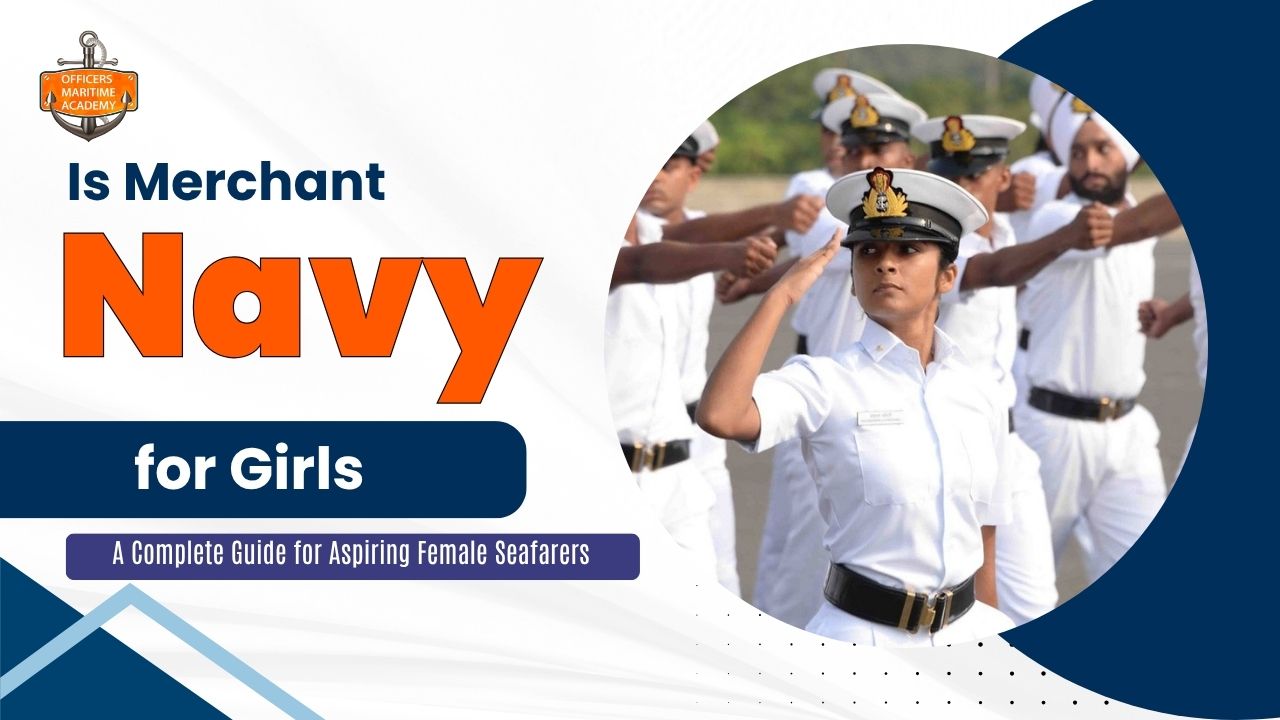
Is Merchant Navy for Girls? A Complete Guide for Aspiring Female Seafarers
Is Merchant Navy for Girls? A Complete Guide for Aspiring Female Seafarers The idea of sailing across oceans, experiencing sunrises on open decks, and working

The idea of sailing across oceans, experiencing sunrises on open decks, and working on massive ships—it’s not just for boys anymore. So let’s dive into the big question: Is Merchant Navy for Girls? Spoiler alert: Absolutely, yes, But let’s unpack that with some honesty and practical info.
Yeah, of course Girls can totally apply. Gone are the days when it was considered a male-only domain. Today, maritime institutes in India and abroad welcome female candidates in various courses. Here’s how you can enter:
Places like IMU (Indian Maritime University), Tolani Maritime Institute, and other top colleges are gender-inclusive. The only catch? You must meet the medical and academic requirements, just like anyone else.
This is a very common doubt among students from non-science backgrounds. Unfortunately, most core sailing roles like deck officer or marine engineer require a background in science, especially with Physics, Chemistry, and Mathematics (PCM) at the 10+2 level.
However, that doesn’t mean the Merchant Navy world is closed for you.
Here are a few alternate paths:
After completing onboard training and gaining experience, some even rise to higher ranks in the support departments.
These roles are vital, especially on cruise ships and passenger vessels.
You can get into these areas with degrees like BBA, MBA, LLB, or relevant vocational training.
So yes, while you can’t be a navigating officer or marine engineer directly with an arts or commerce background, the larger maritime industry still has opportunities for you.
Good question. It’s not just a formality—there’s solid reasoning behind it:
That’s why courses like B.Sc. Nautical Science or B.Tech Marine Engineering ask for Physics, Chemistry, and Mathematics in 10+2.
So, if you’re from arts or commerce—you may not start at the officer level, but you can still sail, grow, and even shift to land-based maritime careers with time and experience.
Honestly, any role you dream of. There’s no fixed “pink” job onboard ships. Women in the Merchant Navy can work as:
And if you’re not into sailing forever, there’s onshore maritime work too—port management, logistics, marine surveying, teaching. Sky’s the limit (or ocean is?).
Okay, this is a fair concern. While it’s generally safe, it really depends on the company and the vessel’s environment. The good news? Many reputed shipping companies like Maersk, Anglo-Eastern, and MSC have zero-tolerance policies for harassment and ensure:
But yes, being mentally strong and assertive helps, because you’re still breaking old stereotypes.
Yep, just like the boys, you need to clear medicals. Key things they check:
If you’re thinking, “Oh no, I wear specs”—don’t worry. Many girls with specs make it through. But color blindness can be a disqualifier for certain roles, especially on deck.
deck.
This is a very common question, and the answer is: Not necessarily, but it’s highly recommended. Most maritime training institutes do not make swimming a compulsory criterion for admission. However, swimming is often taught as part of the basic safety training (STCW course) during pre-sea training.
Why is swimming encouraged?
So while you don’t have to be a pro swimmer before joining, having basic swimming skills gives you a strong edge—both for your training and peace of mind.
Let’s get real here. There’s no gender pay gap on ships. If you’re doing the same job, you’re getting the same pay. Period.
And yes, that’s in Indian rupees. Plus, food, travel, and accommodation are taken care of onboard. Oh, and no income tax while sailing in international waters. Sweet deal, right?
Let’s not sugarcoat it—there are challenges. Some girls feel isolated or judged, especially if they’re the only female on board. Long durations at sea can be mentally exhausting. You miss family events, festivals, even Netflix sometimes.
Then there’s the occasional ignorant co-worker who thinks you can’t lift a fire hose. But these things are changing. Slowly, but they are.
Tips?
Absolutely, Ever heard of Captain Radhika Menon? She became the first Indian woman to receive the IMO Award for Exceptional Bravery at Sea.
Then there’s Sonali Banerjee, widely recognized as India’s first female marine engineer. She graduated from the Marine Engineering Research Institute (MERI), Kolkata, in 1999 and made history in 2001 by becoming the first Indian woman to take charge of a ship’s engine room.
These women have not only sailed but shattered ceilings—setting examples for young girls like you who dream of the sea.
It’s looking bright, honestly. Shipping companies are consciously hiring more women. International maritime organizations are promoting inclusivity. Some ships today have 3-4 women on board, which was unheard of a decade ago.
The digitalization of ships, focus on mental health, and policy changes are making things smoother for everyone—especially women.
Here’s a quick roadmap if you’re thinking, “How do I even begin?”
Bonus tip? Look out for scholarship programs for girls in maritime training. A few NGOs and companies actually sponsor meritorious female candidates.
So, is Merchant Navy for Girls? YES. If you’re someone who craves adventure, loves technology, and doesn’t mind a little solitude at sea, then girl—you’ve found your calling.
It’s not always easy, but it’s always worth it. And every time a woman steps on a ship, she makes the path a little easier for the next one.
Sail strong, dream big, and never let anyone tell you that sea isn’t for you.

Is Merchant Navy for Girls? A Complete Guide for Aspiring Female Seafarers The idea of sailing across oceans, experiencing sunrises on open decks, and working